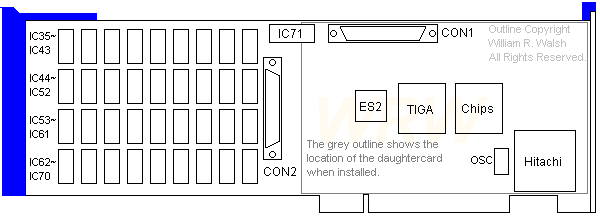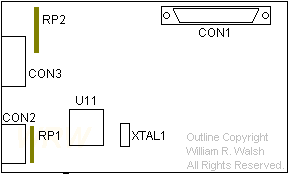|
Adapter ID 6B2C - the QBMCA
utility knows it, and displays a [!] notation, indicating that the adapter
either shares an ID with another or was sold under a variety of brand names. If
you have the adapter definition file (ADF) for this adapter
tell us!
Based on content by William R. Walsh (original HERE).
Xionics XIP-D

Another adapter without component markings on all the parts. Most of the
IDs are totally made up.
Chips C&T P82C611 MCA interface
CON1 Daughtercard connector
CON2 Memory expansion conn.?
ES2 ES2 06117QD1 ASIC
Hitachi HD63085Y DSP
|
IC35-70 TI TMS4C1024DJ-100
IC71 empty DIP socket
OSC 32.0000MHz
TIGA TI TMS34010FNL-50
|
ES2 ES2 (European Semiconductor Structures) 06117QD1 ASIC. ES2 was purchased by Atmel in 1995.
Hitachi HD63085Y DSP - LSI Encoder/Decoder, 32 MHz
TIGA TI TMS34010FNL-50 - DSP/image processor
Xionics XIP-D Daughtercard

CON1 68-pin male connector for base board (looks like a 68-pin F/W SCSI plug)
CON2,3 mini Centronics-like, scanner/printer?
U11 Signetics SCC2692AC1A44 DUART
RP1,2 Resistor networks
XTAL 3.68 (MHz?)
Usage and Purpose (from Jeff White)
I saw your web page about a Xionics board and were asking what it does.
I probably used this board back around 1991 or 1992. It's a co-processor
board for driving a printer and a scanner. The TIGA processor was used to do
manipulations of scanned or loaded images and other processing. One of the
chips on the board, probably the ASIC also did FAX Group III and IV
compression/decompression. The connectors on the daughtercard were to interface
to the Canon printer engine on a LaserJet and the other connector was usually
to hook up to a scanner.
They could have up to 16MB of RAM. I think it had 8MB on the main board and
you could add another 8MB with the rear daughter connector.
It was an expensive board, probably around $2K or $3K back in 1991.
I'm fairly certain it would not drive a display. That would be done by
another card, like an XGA or 8514/A.
Kofax was their main competitor at the time, we also used their boards.
Mr. White later wrote with a bit more information and some history:
Now that I recall more, the back connector on the card was probably for
additional memory. You could install, for the time, a fairly phenomenal amount
of RAM - say 16MB. We build some PC's that one of these boards, a Kofax display
board, SCSI controller, WORM drive, Ethernet, etc. They were very expensive
machines. The worst machines to deal with for us were the PS/2. They were very
troublesome in shoe horning all of the shared memory above 640K needed by MCA
for these devices. Sometimes it was impossible to make some board combinations
work, as there was not enough memory space that it would allow you to
configure.
On the ISA machines, they were usually more lax about memory
configurations.
|